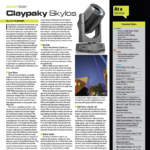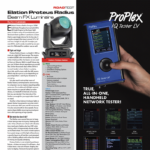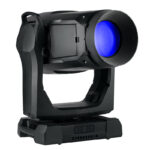It is true, though not necessarily original, to observe that the marketplace for multifunction luminaires has been particularly busy for the past few years. The promise of multiple features on a compact and low-wattage platform is an appealing one, and the makers of these light try their hardest to get the highest-quality effects into moving heads with very little space and demanding cooling requirements. Today, we’re examining the GT-1 hybrid fixture from German Light Products, a (not unsurprisingly) Karlsbad, Germany-based company that has been making intelligent lighting since 1994.
Physically, the GT-1 follows many of the design characteristics that GLP has standardized across its range, including the slim “base” of the fixture, on which are mounted the power and data inputs. This base is very small; this fixture keeps most of the bulky electronics in the yoke of the fixture. The rest of the fixture follows a fairly standard physical layout, with a push-button tilt lock in one arm and the fixture’s menu system on another.

Light Source and Dimming
This fixture’s source is an Osram Sirius 440W lamp, with a nominal color temperature of 7,000K, a short-arc lamp that comes pre-focused in its reflector. These types of lamps have some demanding cooling requirements, and the entire lamp assembly sits in a thermostatically-controlled housing with several fans of various sizes to keep the lamp at its optimal temperature range. Lamp change is a tricky process; there are captive and non-captive screws as well as several components to take out, and this is not a process I’d attempt in the rig. Instead, I’d save lamp change for a workbench. The beam that comes out of this system has a well-defined peak — this is a light for creating aerial effects, not for projecting ultra-detailed patterns onto scenery, so this shouldn’t be an issue in the intended usage context of this light.
Immediately after the lamp housing and angled hot mirrors are the dimming flags, which are also used for strobing effects. These are simple metal flags that close in front of the lamp, with an angular indentation on the leading edge to help make the fade to black more gradual. The dimming quality is slightly patchy, as the optics required for narrow beams make very smooth mechanical dimming very difficult. The dimming curve resembled a slightly bumpy S-curve. I measured 87,800 lux at 5 meters at 50 percent zoom. As mentioned, the flags here are also used for strobing, with all the expected effects including random strobes, pulses, and synchronized flashes included. At focus settings with the rear lens at its closest point to the lamp, the resulting beam can be susceptible to significant vignetting, but this can be reduced or eliminated by changing the focus.
Color Mixing and Gobos
Following the dimmer and shutter flags is the color mixing system, consisting of three mixing wheels and a fixed color wheel with 11 filters plus open, including CTO filters, a minus green filter, and a light frost filter to flatten the peaks in the beam. These are glued into place on the wheel and not user-replaceable. Gaps between adjacent filters are very small, and the GT-1 produces very usable split colors. The mixing wheels are all quite petite, and colors mix pleasingly fast, with the color being reasonably well-homogenized across the beam. Certain mixed colors were a little pale, particularly the red, and the fixed colors help to fill in these gaps in the color mixing system.
Next in line is the gobo module, which consists of a rotating wheel with eight glass gobos plus open, and a fixed gobo wheel with 19 patterns plus open. All gobos on the rotating wheel are interchangeable, and changing requires removal of a metal retaining spring. This process can be done inside the light, but the gobo module also comes out of the light for multiple gobo changes or maintenance. The fixed wheel is a single piece of metal with the gobos stamped into it, and the patterns include several aperture reduction gobos, dots, and crosshatches. Gobo focus was good, with a slight spherical distortion, though this was not objectionable. The glass gobos tended toward patterns that would look best in the air, which is not unexpected with a luminaire like this. Changes between adjacent patterns were snappy on both wheels, while the rotating wheel allowed very smooth rotation down to almost imperceptibly slow speeds. Also on this module is the animation wheel. This is of a familiar design, with a large metal disk with a waves breakup pattern cut into it, which can be inserted across the beam and rotated at varying speeds. One nice feature about this wheel is that you can adjust the axis of rotation from vertical to horizontal within the beam to get varying effects. Insertion took less than a second and was particularly effective and making some interesting fire and water effects.
Three Prisms and Zoom
Further up toward the output lens are the three prisms, which consist of an eight-facet radial prism, a three-facet radial prism, and six-facet linear prism. All the prisms are on the same armature, meaning the user can only select one at a time. Image separation was better for the fixed patterns than the rotating patterns, but I was able to get interesting effects out of each; I particularly liked the square rotating gobo with the prisms. Split colors were also quite effective with the prisms inserted. The prisms rotate and index, and display the same smooth rotational motion down to the slowest speeds. Very close to the prism armature is the frost, which is variable across the beam. The frost is quite heavy and is meant more as a wash effect than as a gobo softening effect.
The unit has two moving lens groups: the rear group is used for focus while the front group (closer to the output lens) is used for zoom. Zoom adjusted smoothly across the range from 3.5º to 57º, and covered its range in about one second. Because the range of the two lens groups overlaps inside the fixture, the fixture will adjust the focus to allow the zoom to operate, riding the focus lens as close as possible to the position the user has specified. Also note the narrowest zoom the fixture is capable of is not available with a gobo inserted, as the lens occupies the open position of the rotating gobo wheel when the rotating gobo is not inserting. If you insert a gobo at the narrowest zoom point, the fixture will automatically move the zoom and focus lenses slightly forward before turning the gobo wheel to prevent collision. This happens automatically but is something to be aware of when programming.
Power input is via a Neutrik PowerCON input, and accepts data via 3 and 5-pin DMX connectors, and via an EtherCON connector for Art-Net and sACN data. Curiously, there is no pass-through for the EtherCON connection, a choice I feel significantly limits the usefulness of including it. The fixture pulls 720W at full tilt, and weighs in at 55lbs (25kg). The unit stands 24.6” (626mm) tall and 18.5” (471mm) wide, and 9” (229mm) deep. Fans are controlled thermostatically, and run only as fast as necessary. Homing from a cold start took a somewhat long 1 minute 56 seconds, and was well-behaved, with the fixture blacking out before resetting, then attaining its final pan and tilt position before coming back on.
The GLP GT-1 enters a marketplace with many competitors, but stands out on the strength of its effects. Having three prisms gives it an edge, and the quality of the effects are a testament to the quality of its engineering.

At a Glance
A Gem of a Hybrid
The GLP GT-1 is an excellent second-generation hybrid light. The quality of the effects and the three prisms are standouts, and the compact nature of the device means it can fit all sorts of places. Programming this fixture is a snap, thanks in part the freedom from having to mess around with different beam and spot modes.
GLP GT-1
PROS: Lot of functions for a compact fixture; bright, three prisms
CONS: No EtherCON passthrough
SPECS
- Light Source: Osram Sirius HRI 440W
- Color Temp: 7300K
- Zoom Range: 3.5-56.7°
- Movement: 8/16 Bit
- Pan/Tilt: 640°/262°
- Control: Art-Net/DMX-512/RDM
- Wireless: Lumenradio CRMX DMX/RDM (optional)
- Dimmer: 0-100% Electromechanical
- Shutter: Electromechanical
- Effect Wheel: Interchangeable/rotating & indexable
- Frost : Yes
- Prism: 3-way/8-fach/6-way linear
- Gobo Wheel 1: Rotating; 8 glass gobos + open
- Gobo Wheel 2: Fixed; 19 patterns plus open
- Color Temp Filter: Mechanical; CTO 2500K, CTB 9000K
- Color Wheel: 11 dichroic color filters; CTB Filter; CTO Filter
- Color Mixing: CMY, Fixed colors
- Connectors: Data – XLR 5-pin; XLR 3-pin, input & output; Power – Neutrik PowerCon
STATS
- Wattage: 720W
- Weight: 55 lbs.
- Size: 18.5” x 9” x 24.6”
- Zoom range: 3.5° to 57°
- MSRP: $9,749
- Manufacturer: GLP
- More Info: www.germanlightproducts.com



